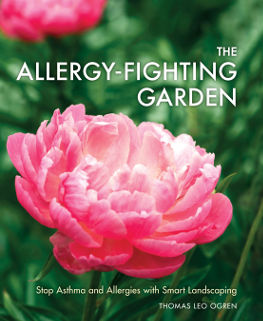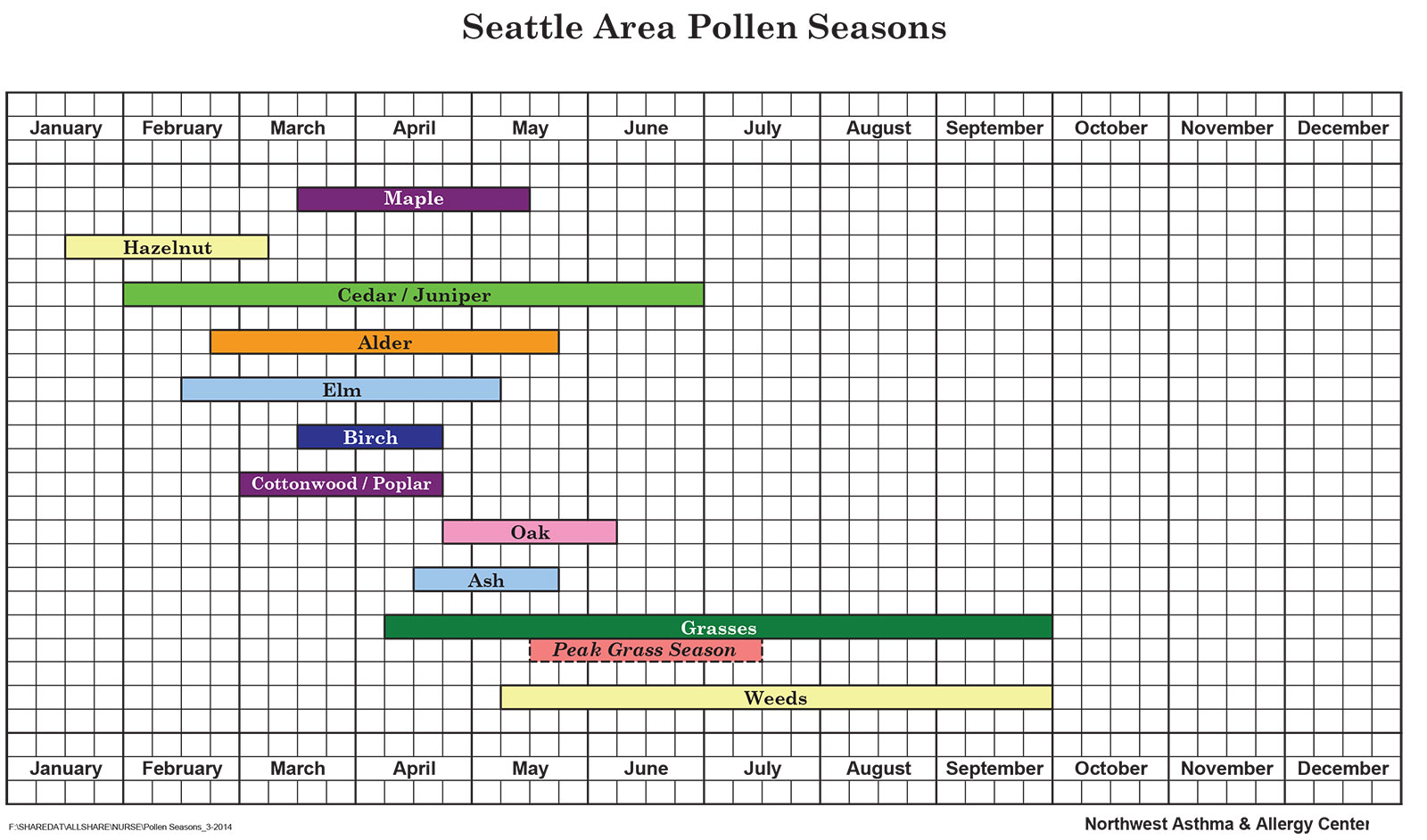Author: Nina Olivier, Built Green Coordinator
Selecting low-allergy, female
species of plants for your garden can help mitigate allergies exasperated by
increased pollen counts from climate change.

Spring is upon us in the Pacific Northwest and for many it also
marks the beginning of allergy season, which affects up to 30% of the US
population and 40% of US children. The CDC expects
that climate change will lead to both higher pollen concentrations and longer
pollen seasons. However, climate change is not the only contributing factor to
the increase in pollen counts, it is only exasperating a situation caused by generations
of selective breeding and prejudicial landscaping decisions.
All plants contain male sex organs called stamens and female
sex organs called pistils. Pollen is dispersed from male stamens and captured
by the female pistil to create seeds for germination. While most plant species
are monoecious and include both male and female reproductive organs, many plant
species are dioecious with individuals that make only pollen or only seeds. In
fact, most of the tree species used for street trees in urban settings are male
dioecious trees.

Tom Ogren, author of The Allergy-Free Garden, blames
most of the allergy inducing problems on selectively only landscaping with male
plants. He explains that male species of shrubs, trees, and flowers produce
pollen and other air particles. “It all has to do with sex and the need to
plant female plants.” Female
trees were thought to produce unattractive and unwelcome litter in the form of fruit,
seeds, flowers, cones, pods, and cotton. Since the 1970’s, city planners and landscaping
crews began planting male trees to reduce cleanup costs and efforts.
Ogren states, "I was able to
trace it to the fact that many street trees that were planted years ago have
finally reached maturity. And those trees are all male and now overloading the
air with pollen." With this increased demand for male trees,
horticulturalists began selectively breeding and cloning more and more dioecious male plant species,
moving beyond trees into shrubs and flowers. Increasing more and more
pollen-only producing varieties and species to fill the landscapes that surround
us.
Ironically,
if city planners and landscapers had prioritized female trees and plants, in
the same way as male plants, neither pollen nor unwanted seeds or fruit would
cause issues. Female plants do not produce fruits or seeds if there are no
males of the same species within 20 to 30 feet from its roots. He goes on to explain that
allergy-reducing landscaping includes not just understanding the
importance of plant sex, but also encouraging pollinators and eliminating mold growth
that can occur in hedges and compost piles.
From his
observations Ogren now believes that the reason so many butterflies are
disappearing is because the [female] nectar-producing trees were a major food
source. "And they are disappearing because they are being replaced by the [male]
pollen-producing trees," said Ogren. Planting native species of plants supports native pollinators with the foods they are
accustomed to. Furthermore, non-native plants may become stressed since they
are not used to the climate, and therefore, may produce more pollen. To guide
cities to plant less allergenic trees, Ogren developed the Ogren Plant Allergy Scale (OPALS). The scale rates plants from 1–10
based on their allergy potential.
Grass is a
major pollen producer, thus, to reduce allergy triggering pollen, the Asthma
Society recommends mowing grasses regularly before it flowers. Better
Home and Gardens recommends planting species that are pollinated by bees; the pollen of these
species is heavier and sticky and therefore stays on the bees rather than floating
around in the air. In addition, mold growth in hedges and compost can also affect
allergies. To discourage mold spores Ogren recommends keeping hedges trimmed
regularly to increase air flow between the branches, keeping compost bins
covered, and turning compost piles about every 2 to 4 weeks.
Local pollen
counts can be tracked and monitored through the US Air Quality Index. The University of Illinois
Extension recommends reducing exposure to plants that flare up allergens
through wearing long sleeved shirts, long pants, gloves, hat, and even a mask
while gardening.

Increases in carbon emissions and climatic changes in weather
patterns are causing more people around the world to experience negative health
effects from pollen and other outdoor allergens. According to the CDC, individuals
with preexisting respiratory illnesses such as asthma, are more sensitive to pollen,
which has been linked to increases in asthma attacks and associated medical
costs that exceed $3 billion every year. Decreasing the plants that contribute
more pollen into the air can increase quality of life, especially for those
already living in urban low-quality air zones.
The following is Allergic Living’s list of low-allergy options for your garden:
|
Flowering Plants
|
Shrubs/Bushes/Herbs
|
|
Lathyrus odoratus – Sweet pea
|
Coleus blumei – Coleus
|
|
Catharanthus roseus – Periwinkle
|
Hosta – Hosta, plantain lily
|
|
Digitalis – Foxglove
|
Physalis – Chinese lantern
|
|
Impatiens – Impatiens
|
Sempervivum – Hens and chicks
|
|
Myosotis – Forget-me-nots
|
Hydrangea grandiflora – Big leaf hydrangea
|
|
Nierembergia – Cup flower
|
Viburnum – Viburnum shrubs, highbush cranberry, nannyberry
|
|
Petunia – Petunia
|
Heuchera – Coral bells (many varieties)
|
|
Viola – Johnny jump up, pansy, violet
|
Teucrium crispum – Wood sage
|
|
Brodiaea – Elephant’s ears
|
Physocarpus opulifolius – Dart’s gold, ninebark
|
|
Crocus – Spring-flowering crocus
|
Bergenia – Elephant’s ears
|
|
Cyclamen – Cyclamen
|
Kolkwitzia amabilis – Beauty bush
|
|
Galanthus – Snowdrops*
|
Aronia melanocarpa – Black chokeberry
|
|
Gladiolus – Gladiolus
|
Rodgersia pinnata – Featherleaf rodgersia
|
|
Hyacinth – Hyacinth (numerous varieties)
|
Helianthemum – Sunrose, rock rose
|
|
Gentiana – Gentian
|
Gaura – Gaura, beeblossom
|
|
Geranium – True geranium, cranesbill
|
Vaccinium corymbosum – Blueberry bush
|
|
Hemerocallis – Day lily
|
Berberis vulgaris – Barberry bush
|
|
Peony – Peony
|
Daphne – Daphne
|
|
Polemonium – Jacob’s ladder
|
Nandina domestica – Nandina
|
|
Rhododendron – Azalea, rhododendron
|
Salvia greggii – Autumn sage
|
|
Fuchsia – Fuchsia
|
Salvia clevelandii – Cleaveland sage, blue sage
|
|
Dianthus – Carnation, pinks
|
Trees
|
|
Papaver – Poppy
|
Stick to female trees, which may drop berries or seeds but don’t produce pollen
|
|
Begonia – Fibrous or tuberous begonia
|
Persimmon – persimmon tree
|
|
Rosa – Rose (avoid high-scent varieties)
|
Amelanchier lamarkii – juneberry tree*
|
|
Phlox – Phlox*
|
Vines/Climbing Plants
|
|
Iris – Iris
|
Thunbergia alata – Black-eyed Susan vine
|
|
Erythrocoma triflora – Prairie smoke
|
|
|
Kniphofia – Red Hot Poker
|
|
|
Clematis – Clematis
|
|
|
Tulipa gesneriana – Tulip (bulbs may irritate sensitive skin)
|
|
|
Penstemon – Beardtongue
|
|
|
Antirrhinum – Snapdragon
|
|
|
Asclepias tuberosa – Butterfly weed
|
|
|
Hibiscus – hibiscus
|
|
|
Narcissus – Daffodil
|
|
|
Bulbine frutescens – bulbine
|
|
*Pictured below
Amelanchier lamarkii – Juneberry tree